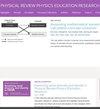运动学概念试验的验证和结构分析
Physical Review Special Topics-Physics Education Research
Pub Date : 2017-04-10
DOI:10.1103/PHYSREVPHYSEDUCRES.13.010115
引用次数: 29
摘要
运动学概念测试(KCT)是一项多项选择题测试,旨在评估高中学生对运动学概念的理解。测试包括49个关于速度和加速度的选择题,这些选择题基于七个运动学概念,使用三种不同的表示。在本文的第一部分中,我们描述了KCT的开发和验证过程。我们将KCT应用于338名参加运动学传统教学的瑞士高中生。我们分析了反应数据,以提供测试的心理测量特性。在第二部分,我们给出了测试的结构分析结果。通过对664名学生答案的探索性因素分析,最终揭示了七个运动学概念作为影响因素。然而,分析揭示了概念的层次结构。在较高的层次上,数学概念组合在一起,然后在较低的层次上分解成物理概念。此外,似乎在一种表征中理解概念的学生很难将概念转移到另一种表征中的类似问题中。这两个结果对运动学教学都有启示意义。首先,事先教授数学概念可能对学习运动学有益。其次,指令的设计必须让学生了解不同表征之间的变化。本文章由计算机程序翻译,如有差异,请以英文原文为准。
Validation and structural analysis of the kinematics concept test
The kinematics concept test (KCT) is a multiple-choice test designed to evaluate students' conceptual understanding of kinematics at the high school level. The test comprises 49 multiple-choice items about velocity and acceleration, which are based on seven kinematic concepts and which make use of three different representations. In the first part of this article we describe the development and the validation process of the KCT. We applied the KCT to 338 Swiss high school students who attended traditional teaching in kinematics. We analyzed the response data to provide the psychometric properties of the test. In the second part we present the results of a structural analysis of the test. An exploratory factor analysis of 664 student answers finally uncovered the seven kinematics concepts as factors. However, the analysis revealed a hierarchical structure of concepts. At the higher level, mathematical concepts group together, and then split up into physics concepts at the lower level. Furthermore, students who seem to understand a concept in one representation have difficulties transferring the concept to similar problems in another representation. Both results have implications for teaching kinematics. First, teaching mathematical concepts beforehand might be beneficial for learning kinematics. Second, instructions have to be designed to teach students the change between different representations.
求助全文
通过发布文献求助,成功后即可免费获取论文全文。
去求助
来源期刊
自引率
0.00%
发文量
0
审稿时长
>12 weeks
期刊介绍:
Physical Review Special Topics - Physics Education Research (PRST-PER) is a peer reviewed electronic-only journal sponsored by The American Physical Society (APS), the American Association of Physics Teachers (AAPT) and the APS Forum on Education. The journal covers the full range of experimental and theoretical research on the teaching and/or learning of physics. PRST-PER is distributed without charge and financed by publication charges to the authors or to the authors" institutions. The criteria for acceptance of articles include the high scholarly and technical standards of our other Physical Review journals.

 求助内容:
求助内容: 应助结果提醒方式:
应助结果提醒方式:


